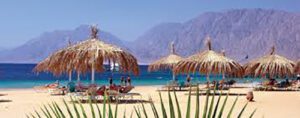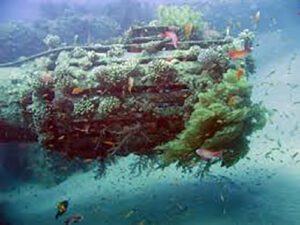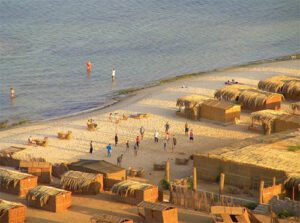Devil’s Head is a world on its own. It is cut off from all urban facilities, including paved roads, high-rises and modern automobiles.
However, the parched area location, around 500 kilometres east of Cairo, near the coastal town of Nuweiba in Sinai, is a fountain of excitement, rest and meditation.
The area derives its name from its location on the tip of Nuweiba’s Red Sea coast.
The name also derives from the magnificent corals off its coast and its particular marine life.

Devil’s Head has become an Egyptian attraction that outrivals all others in this country.
It is one of the most fascinating places for nature and meditation lovers.
From the very simple nature of accommodation in the area, to the beach, the very nice activities visitors can make there and the food, Devil’s Head offers visitors an experience that lingers in their memory for years.
The area is breathtaking at first sight. It is made of a number of camps and depends on the most basic of requirements for life.
Televisions are rare, toilets are very simple and the cottage-like rooms of the camps with their palm leaf ceilings have nothing in them but beds, wardrobes and simple mats on the ground.
Under this austere existence, however, there is unlimited joy for nature lovers and adventurers.

Outside the simple cottages, visitors find themselves in direct and uninterrupted contact with the clear sky, the Red Sea and the soft sands of the beach.
Rich in natural beauty, Devil’s Head is a place for those who do not want to spend a lot of money.
The area’s camps charge a visitor a maximum of $22 per night, including bed, breakfast and dinner.
The camps serve Bedouin cuisine, including fava beans, eggs with pastirma (a highly seasoned, air-dried cured beef of Anatolian origin), baba ghanoush (a Levantine dish of eggplant mixed with onions, tomatoes, olive oil and various seasonings) and red tea for breakfast.
Dinners usually contain fish cooked in a manner suitable to the type of the catch and rice or pasta.

Most noticeable inside the camps is the generosity of workers, room service and the people who serve food.
Devil’s Head is not, meanwhile, only about the sky, the breeze, the sea and the sands.
It is only the gate to a whole world of adventure and beauty. Snorkeling, swimming, mountain climbing, safari, camping and enjoying the sun are but a few of the activities visitors can make in the area.
Close to the area is Tarabeen fortress, a 500-year-old structure built by the Mamluk Sultan Ashraf al-Ghawri to defend Sinai from Ottoman invaders.
The fortress was also used for security purposes, especially during the Muslim pilgrimage season.
Safaris into the desert and mountainous hinterland of Devil’s Head are always rewarding. The mountains and the hills that fill the space for kilometres behind the Red Sea coast assume diverse colours and offer visitors a generous treat of beauty.

Snorkeling is a memorable experience in this area with colourful corals and fish that take divers to a world of dreams.
Devil’s Head can be reached from Nuweiba that can be reached from Cairo via multiple means, including buses and taxis.
It can take travelers around 4 hours to reach Nuweiba from the Egyptian capital.








Discussion about this post